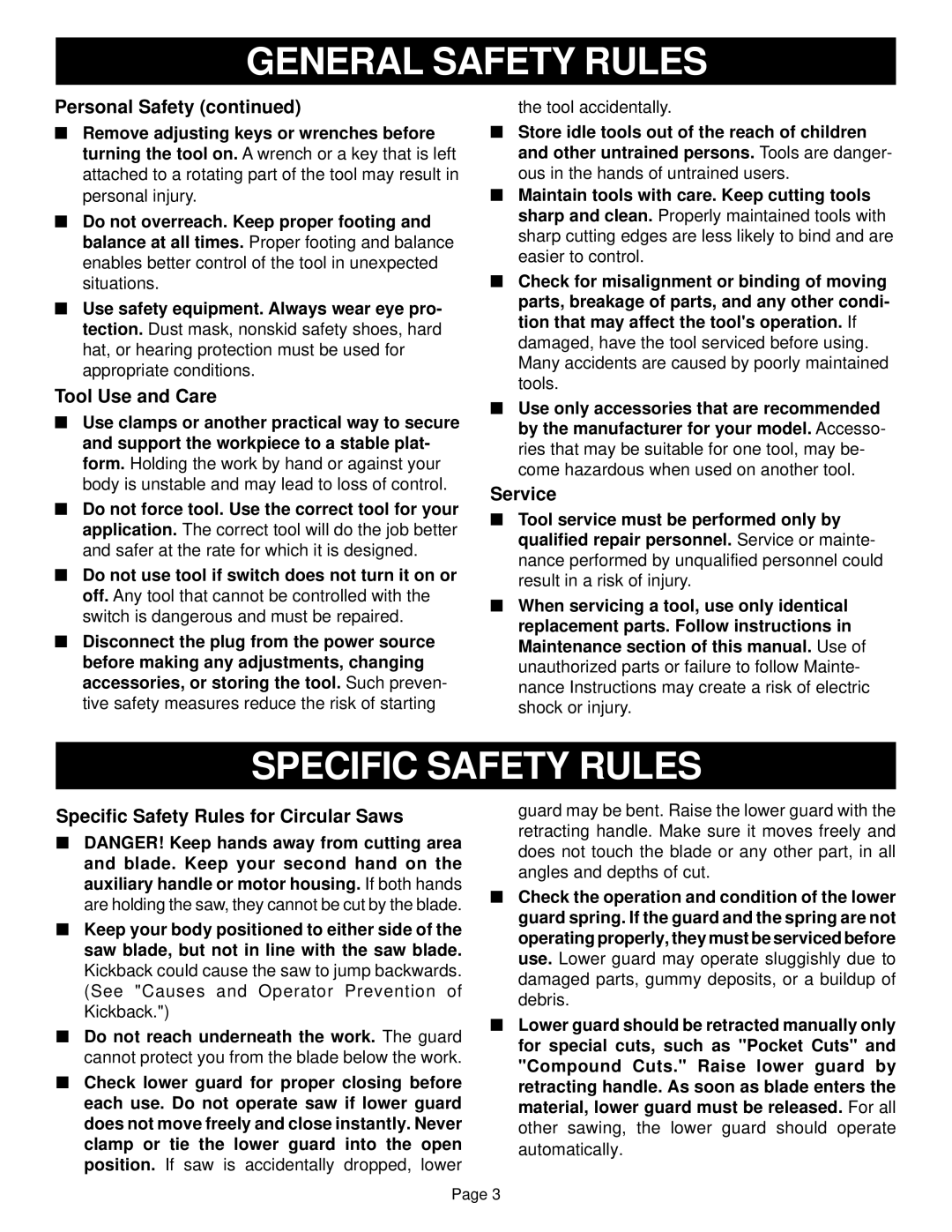
GENERAL SAFETY RULES
Personal Safety (continued)
■Remove adjusting keys or wrenches before turning the tool on. A wrench or a key that is left attached to a rotating part of the tool may result in personal injury.
■Do not overreach. Keep proper footing and balance at all times. Proper footing and balance enables better control of the tool in unexpected situations.
■Use safety equipment. Always wear eye pro- tection. Dust mask, nonskid safety shoes, hard hat, or hearing protection must be used for appropriate conditions.
Tool Use and Care
■Use clamps or another practical way to secure and support the workpiece to a stable plat- form. Holding the work by hand or against your body is unstable and may lead to loss of control.
■Do not force tool. Use the correct tool for your application. The correct tool will do the job better and safer at the rate for which it is designed.
■Do not use tool if switch does not turn it on or off. Any tool that cannot be controlled with the switch is dangerous and must be repaired.
■Disconnect the plug from the power source before making any adjustments, changing accessories, or storing the tool. Such preven- tive safety measures reduce the risk of starting
the tool accidentally.
■Store idle tools out of the reach of children and other untrained persons. Tools are danger- ous in the hands of untrained users.
■Maintain tools with care. Keep cutting tools sharp and clean. Properly maintained tools with sharp cutting edges are less likely to bind and are easier to control.
■Check for misalignment or binding of moving parts, breakage of parts, and any other condi- tion that may affect the tool's operation. If damaged, have the tool serviced before using. Many accidents are caused by poorly maintained tools.
■Use only accessories that are recommended by the manufacturer for your model. Accesso- ries that may be suitable for one tool, may be- come hazardous when used on another tool.
Service
■Tool service must be performed only by qualified repair personnel. Service or mainte- nance performed by unqualified personnel could result in a risk of injury.
■When servicing a tool, use only identical replacement parts. Follow instructions in Maintenance section of this manual. Use of unauthorized parts or failure to follow Mainte- nance Instructions may create a risk of electric shock or injury.
SPECIFIC SAFETY RULES
Specific Safety Rules for Circular Saws
■DANGER! Keep hands away from cutting area and blade. Keep your second hand on the auxiliary handle or motor housing. If both hands are holding the saw, they cannot be cut by the blade.
■Keep your body positioned to either side of the saw blade, but not in line with the saw blade. Kickback could cause the saw to jump backwards. (See "Causes and Operator Prevention of Kickback.")
■Do not reach underneath the work. The guard cannot protect you from the blade below the work.
■Check lower guard for proper closing before each use. Do not operate saw if lower guard does not move freely and close instantly. Never clamp or tie the lower guard into the open position. If saw is accidentally dropped, lower
guard may be bent. Raise the lower guard with the retracting handle. Make sure it moves freely and does not touch the blade or any other part, in all angles and depths of cut.
■Check the operation and condition of the lower guard spring. If the guard and the spring are not operating properly, they must be serviced before use. Lower guard may operate sluggishly due to damaged parts, gummy deposits, or a buildup of debris.
■Lower guard should be retracted manually only for special cuts, such as "Pocket Cuts" and "Compound Cuts." Raise lower guard by retracting handle. As soon as blade enters the material, lower guard must be released. For all other sawing, the lower guard should operate automatically.
Page 3
